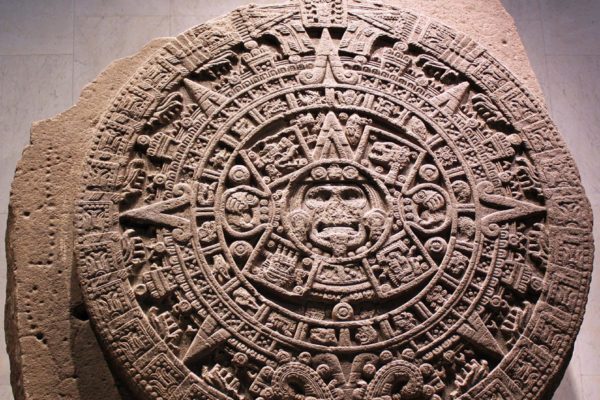AUSTIN, Texas — Longstanding ideas about the face of one of the most famous works of Aztec sculpture are being challenged by a new theory from a University of Texas at Austin researcher.
Art history professor David Stuart argues that the image on the Aztec Sun Stone is more than a calendar or a simple representation of the sun god, but rather a named portrait of the ruler Montezuma II as a “sun king,” dedicated a few years before the arrival of Spanish conquistador Hernán Cortés.
Scholars have debated about the identity of the central face on the stone for more than 100 years, but this new line of inquiry from Stuart shows there may be more to the story.
“This new theory historicizes the imagery and the monument, going beyond seeing it as just a religious or cosmological sculpture,” Stuart said. “Previous scholars had identified the name glyph of Montezuma on the stone, but the next step was identifying the name as a label and not just a note about who made it.”
During a recent trip to Mexico City, Stuart guided a UT delegation through the National Museum of Anthropology and its iconic display of the Aztec Sun Stone. “I remember noticing a new detail in the hieroglyphs on the stone that gave me pause,” he said. “I continued with the tour, but I made a mental note to return to the photos and drawings. That moment led me toward a new line of inquiry.”
The famous stone, also known as the Aztec Calendar Stone, was unearthed in Mexico City in 1790. It is almost 12 feet in diameter and covered in hieroglyphs, with a solar deity at its center. Stuart believes that the two glyphs that appear above the central face refer to Montezuma II and the Méxica patron god Huitzilopochtli. Based on what scholars know about text-image relationships in Mesoamerican art, Stuart hypothesizes that their placement has a direct bearing on the identity of the face itself. In Méxica art, name glyphs seldom function as standalone entities and are instead almost always found in conjunction with portraits and images as a means of image identification. Stuart argues that they both label the central face of a deified king — Montezuma II — embodying or assuming the supernatural identity of Huitzilopochtli.
“The face on the Aztec Sun Stone is not either the face of a sun god or a portrait of Montezuma, but both,” Stuart said. “Montezuma looks out from the center of the stone as a personalized representation of time and space. It’s a metaphysical depiction of royal power.”
He also speculates that the stone might have been originally displayed in front of the king’s palace in ancient Tenochtitlan, in front of what is now the Palacio Nacional in Mexico City. In his tentative hypothesis, Stuart argues that two other signs on the stone, which frame the face and create the circular design of the stone, refer to “sun” and “market” and that they are references to a substantial market and the palace of Montezuma II that have been documented near the stone’s found location. Historical texts published by the 16th-century Dominican friar Diego Durán refer to an “image of the sun” in the same area, indicating that it may have been on display in or near what is now the Plaza Mayor in Mexico City for decades after the 1521 conquest of Tenochtitlan by the Spaniards.
Stuart’s full findings appear in the journal Arqueología Mexicana.




